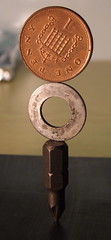I think I should have become an engineer.
I like problem solving, I like building things and dammit, I need an excuse for the CNC mill I want.
What prompted this? Well it is the annual laser repair time. For a piece of equipment that cost somewhere between £30k – £50k, you have to wonder why various bits of the high pressure chamber (3 atmospheres of corrosive gas) is made from a combination of Japanese lamp post metal* and tinfoil.
The two ends of the laser – the plates where the mirrors are mounted are made of the softest aluminium they could find. Now corrosive gas under high pressure + soft, easily corroded metal. Are you thinking what I’m thinking? Yes the whole fucking thing was stuck fast and looking furrier than a 12 week old cheese roll.
At some point a pin hole leak had developed around an O-ring. It wasn’t there 3 months ago when we last looked. The whole of the front mirror mount was a mess, and a £250 optic was buried in the middle of it.
I’ll spare you the details, but in the end we used an angle grinder, a chisel and a club hammer to free everything up. Now I’ve to work out a way to clean everything and put it all back so it is once again gas tight.
Would it have really been so much trouble to make the end pieces from stainless steel or chrome?
Now if I had a CNC mill I could machine up the parts myself…
* You know the stuff I mean. Tools made from it disintegrate the moment you use them for anything serious, screws and bolts made from it shear or chew up when you try and shift ’em, etc.

